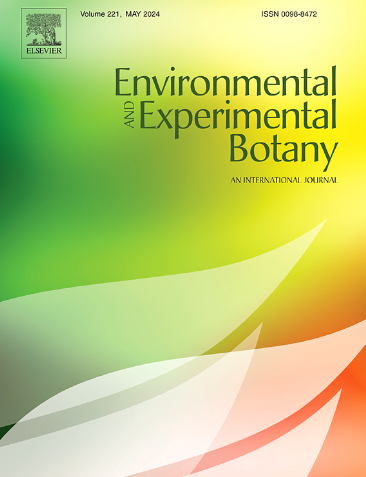独角蜜内酯增强番茄对盐胁迫的生理生化反应
IF 4.7
2区 生物学
Q2 ENVIRONMENTAL SCIENCES
引用次数: 0
摘要
盐胁迫对包括蔬菜在内的植物作物的影响越来越大。己糖内酯(SLs)参与调节植物对渗透胁迫的反应。为了明确地证明内源SLs在盐胁迫下的作用,我们比较了SL生物合成基因CCD7(类胡萝卜素裂解DIOXYGENASE7)沉默的番茄植株与相对野生型植株的反应,并测试了特定的SL类似物对映体GR245DS在胁迫植物中的作用。施盐增加了基质电导率、叶片和根系Na+浓度,降低了茎水势。盐度抑制了植株生长,降低了气孔导度,增加了叶片脯氨酸含量,增强了活性氧清除酶的活性。缺硫植株对胁迫的敏感性更强,叶片脯氨酸、K+和Mg2+浓度均低于野生型植株。缺硫植株叶片MDA浓度较高。胁迫下的气孔导度和叶片可溶性糖浓度不受遗传SL耗竭的影响,但GR245DS处理叶片的气孔导度和叶片可溶性糖浓度分别降低和升高。GR245DS处理还可调节叶片活性氧清除酶的活性。我们的研究结果明确地表明,内源SLs通过影响离子和有机溶质的差异积累以及对氧化应激的反应,有助于提高番茄对盐胁迫的耐受性。本文章由计算机程序翻译,如有差异,请以英文原文为准。
Strigolactones enhance physiological and biochemical responses to salinity stress in tomato
Salinity stress is increasingly affecting plant crops, including vegetables. Strigolactones (SLs) are involved in modulating plant responses to osmotic stress. To unequivocally demonstrate the role of endogenous SLs under salt stress, we compared the responses of tomato plants silenced for the SL biosynthetic gene CCD7 (CAROTENOID CLEAVAGE DIOXYGENASE7) with the relative wild-type and tested the effect of the specific SL analogue enantiomer GR245DS in stressed plants. Salt application increased the substrate electrical conductivity and leaf and root Na+ concentration, and decreased stem water potential. Salinity also restrained growth, reduced stomatal conductance, increased content of leaf proline, and enhanced activity of ROS-scavenging enzymes. SL-depleted plants were more susceptible to stress, showing stronger reduction of shoot growth than wild-type plants, and lower leaf concentration of proline, K+ and Mg2+. Leaf MDA concentration was higher in SL-depleted plants. Stomatal conductance and leaf soluble sugar concentration under stress were not affected by genetic SL depletion, but they respectively decreased and increased in leaves treated with GR245DS. Activity of ROS-scavenging enzymes in leaves was also modulated by GR245DS treatment. Our results unambiguously demonstrate that endogenous SLs contribute to improving tolerance to salt stress in tomato by affecting differential accumulation of ions and organic solutes, as well as responses to oxidative stress.
求助全文
通过发布文献求助,成功后即可免费获取论文全文。
去求助
来源期刊

Environmental and Experimental Botany
环境科学-环境科学
CiteScore
9.30
自引率
5.30%
发文量
342
审稿时长
26 days
期刊介绍:
Environmental and Experimental Botany (EEB) publishes research papers on the physical, chemical, biological, molecular mechanisms and processes involved in the responses of plants to their environment.
In addition to research papers, the journal includes review articles. Submission is in agreement with the Editors-in-Chief.
The Journal also publishes special issues which are built by invited guest editors and are related to the main themes of EEB.
The areas covered by the Journal include:
(1) Responses of plants to heavy metals and pollutants
(2) Plant/water interactions (salinity, drought, flooding)
(3) Responses of plants to radiations ranging from UV-B to infrared
(4) Plant/atmosphere relations (ozone, CO2 , temperature)
(5) Global change impacts on plant ecophysiology
(6) Biotic interactions involving environmental factors.
 求助内容:
求助内容: 应助结果提醒方式:
应助结果提醒方式:


